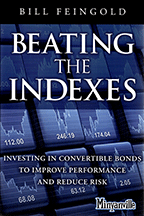 (296 pages, $44.99 hardcover, 2012, ISBN 978-0-13-288594-2) by Bill Feingold, published by FT Press, an imprint of Pearson.
(296 pages, $44.99 hardcover, 2012, ISBN 978-0-13-288594-2) by Bill Feingold, published by FT Press, an imprint of Pearson.BOOKS FOR TRADERS
 (296 pages, $44.99 hardcover, 2012, ISBN 978-0-13-288594-2) by Bill Feingold, published by FT Press, an imprint of Pearson.
(296 pages, $44.99 hardcover, 2012, ISBN 978-0-13-288594-2) by Bill Feingold, published by FT Press, an imprint of Pearson.
Indexing is becoming dangerous, thanks to its bias toward overvalued, large-cap stocks likely to hit periods of underperformance. This guide shows how to exploit the biases of index investing and make winning investments. It exposes growing cracks in the theory of index investing and presents long-term strategies capable of consistently outperforming index investors. If you are tired of minimal returns that disappear with the slightest market volatility, then this may be the book you’re looking for.
additional information: www.ftpress.com
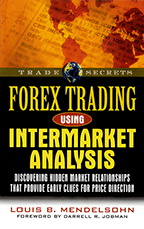 (107 pages, $19.95 paperback, 2006, ISBN 978-1592802951) by Louis B. Mendelsohn, published by Marketplace Books.
(107 pages, $19.95 paperback, 2006, ISBN 978-1592802951) by Louis B. Mendelsohn, published by Marketplace Books.
As economies grow and information technologies advance, markets become more globalized and sophisticated. The forex market plays an increasing central role. It is a 24-hour market with transactions estimated at $1.5 to $2.5 trillion a day. This exceeds all major exchanges for equities, futures, and other instruments in the world combined. This book explores the application of intermarket analysis to the foreign market and details a number of fundamental and technical factors that have a bearing on forex values.
additional information: www.marketplacebooks.com
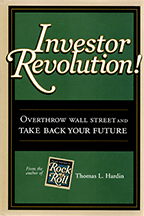 (233 pages, $24.95 hardcover, 2007, ISBN 978-1-933669-06-9) by Thomas L. Hardin, published by Canterbury Publishing.
(233 pages, $24.95 hardcover, 2007, ISBN 978-1-933669-06-9) by Thomas L. Hardin, published by Canterbury Publishing.
In today’s market, Wall Street’s outdated methods can be hazardous to your wealth. This book helps you fight back. You’ll learn why Wall Street focuses on short-term performance to sell products at the expense of lifelong successful investing. Revolutionary investment processes and breakthroughs will be explained. This book is about redefining your Wall Street experience, about cutting-edge investing tools, and about sustaining long-term success.
additional information: www.CanterburyGroup.com
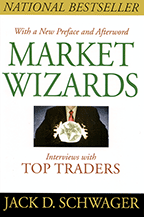 (480 pages, $24.95 paperback, 2012, ISBN 978-1-118-27305-0) by Jack D. Schwager, published by John Wiley & Sons.
(480 pages, $24.95 paperback, 2012, ISBN 978-1-118-27305-0) by Jack D. Schwager, published by John Wiley & Sons.
This is the investment classic, updated with a new preface and afterword. It features interviews with 17 of the most successful market beaters including Bruce Kovner, Richard Dennis, Paul Tudor Jones, Michael Steinhardt, Ed Seykota, Marty Schwartz, and Tom Baldwin. It is packed with real-life anecdotes from the trading world. From the electrical engineer from MIT whose computerized trading earned returns of 250,000% over 16 years to the trader who, after wiping out several times, successfully turned a $30,000 investment into an $80 million fortune, Schwager identifies the factors that define a true Market Wizard.
additional information: www.wiley.com
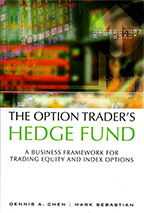 (219 pages, $49.99 hardcover, 2012, ISBN 978-0-13-282340-1) by Dennis A. Chen and Mark Sebastian, published by FT Press.
(219 pages, $49.99 hardcover, 2012, ISBN 978-0-13-282340-1) by Dennis A. Chen and Mark Sebastian, published by FT Press.
If you want to earn a steady, reliable income from options, you need to run your option portfolio as a business. The authors introduce a practical “insurance business” framework for trading options: a framework built on techniques proven in the world’s largest financial institutions. Chen and Sebastian identify the option concepts most critical to long-term success and present core income strategies based on selling rather than purchasing options. Using real-world examples, they walk you through setting up your option business, offering an “operations manual” for addressing every day-to-day issue you’ll face. Drawing on their experience, they teach lessons about maintaining discipline, managing volatility and risk, handling infrastructure and payments, and more. To earn reliable income from options, you must be systematic, disciplined, and professional. This book will guide you.
additional information: www.ftpress.com
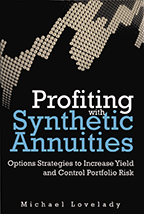 (230 pages, $49.99 hardcover, 2012, ISBN 978-0-13-292911-0) by Michael Lovelady, published by FT Press.
(230 pages, $49.99 hardcover, 2012, ISBN 978-0-13-292911-0) by Michael Lovelady, published by FT Press.
Option-based “synthetic annuities” allow investors to generate higher returns, provide downside protection, and utilize risk more efficiently. This strategy shows how to use them to support a range of trading and investing goals. Synthetic annuities blend the best features of traditional portfolios with the risk management discipline of quantitative investing, increasing current yields while reducing volatility. The strategy is presented with graphics and simplified models. The author explains the entire “ecosystem” of theories, products, and tools surrounding synthetic annuities, and shows exactly how to integrate them with other investment and portfolio management techniques.
additional information: www.ftpress.com